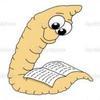
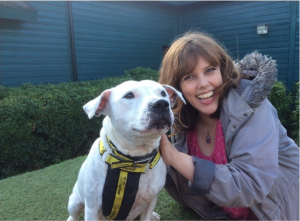
Jane Elson with staffie Shireen from The Dogs Trust at Harefield – photo provided by author
JANE ELSON – A BIOGRAPHY
After performing as an actress and comedy improviser for many years, Jane fell into writing stories and plays. A Room Full of Chocolate was her first book for children and won Peters’ Book of the Year and the Leeds Book Award as well as being longlisted for the Branford Boase and nominated for the Carnegie Medal. Her second book How To Fly With Broken Wings has been Longlisted for Hillingdon Secondary Book of the Year and the Hounslow School Libray Service Junior Book Award.When she is not writing Jane spends her time running creative writing and comedy improvisation workshops for children with special educational needs and volunteering at Kentish Town City Farm. Jane was also Selected as a New Voice in the Guardian’s guide to The Best New Children’s Books 2014, Jane is described as ‘A new author to watch.’
Click on the books to get to their description on GoodReads!
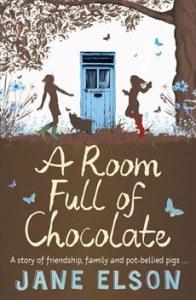
For my review of A Room Full Of Chocolate please click HERE.
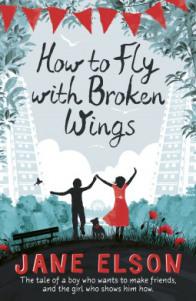
INTERVIEW WITH JANE ELSON
I’d like to welcome Jane to bibliobeth today and thank her for her time in giving this interview!
1.) How To Fly With Broken Wings is your second novel, following the amazing A Room Full Of Chocolate. After the huge success of your debut novel did you find it difficult to write the second or was the story always there to be told?
I actually started writing How to Fly With Broken Wings before I had finished the draft of A Room Full Of Chocolate, which I submitted to my now agent, Jodie Hodges. I was attending Lou Kuenzler’s Writing for Children Workshop at City Lit and the first chapter just fell out on the page and the story started to pour from me. I really enjoyed the experience of writing in the two voices of Willem and Sasha. I think How to Fly is the most complex project I have ever tackled but I loved every moment of working on it, and for that I have my amazing editor Naomi Greenwood to thank. She makes the editing process a creative joy, so even when I was working long- long hours on my story, it was enjoyable. However tired I got it never felt like a slog as Naomi has such a talent for helping me bring out the best in my writing.
2.) How To Fly With Broken Wings follows a young boy with Aspergers Syndrome who is trying his hardest to make friends. Have you had any personal experience with bullying and how did it affect your life?
Yes, I was bullied at school. I was an undiagnosed dyslexic and dyspraxic, which made me an easy target. The kid who was clumsy and very uncoordinated – so easy to mock. I hated PE so much. So much bullying seemed to happen in those lessons. I remember the teacher doing this thing where the last child to get changed after swimming and back on the coach would lose 10 house points. Of course it was always me. Getting changed quickly and dealing with buttons and shoe laces can be a challenge for a dyspraxic!
I remember as if it were yesterday, the misery of trying to run to the coach with half my clothes on inside out and still wet from swimming as I had not had time to dry myself properly.
I would say bullying affected my confidence in a big way. I now work one morning a week with dyslexic and dyspraxic children, some of whom have Aspergers Syndrome.
The bullying I went through has given me a big insight and understanding into some of the challenges many young people face.

From Jane’s Pinterest board: moods by LEGO face, source – designholic at flickr.com
3.) Willem and Sasha bond in the novel over their love of flying. What kind of research did you have to carry out in order to bring their story to life?
Oh my goodness, I have never done so much research in my life! The acknowledgement list at the back of my book is huge. There are too many people to mention all of them here so I will just name a few, starting with the nitty gritty – the technical stuff.
I read a whole manual on How To Fly a Spitfire! I was also lucky enough to coincidently bump into a man, Andrew Pearce, who knew everything about Spitfires.
My cousin Sally helped me with the science and made it fun and easy for me to understand, as it’s not my strongest subject.
My publisher, Hodder Children’s Books, was adamant – and rightly so – that if I was going to tell the story I wanted to tell, then the bullies had to get the appropriate punishment.
My friend Paula, put me in touch with Steven Wilkinson, a retired policeman, who was able to advise me on police procedure for the climax of the story. My friend Curtis Ashton, a social worker who has worked extensively with Young Offenders, was so valuable in making sure that we had the appropriate punishments for Finn and his gang in How To Fly With Broken Wings.
Next came the research for the historical texture of my story. The research I enjoyed the most was visiting the vintage shop Circa who helped me explore the beautiful textures and fabrics of 1940’s fashion and let me peep in the 1940’s handbags, smell the face powder, feel the silk and embody Rachel’s world – the female Spitfire Pilot in my story – as she danced the night away in her red dress. My friend Leon, an expert in dance, talked me through 1940’s dancing – the jitterbug and jive.
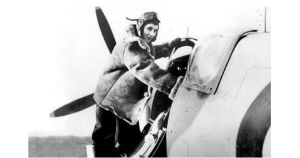
Diana Barnarto Walker – one of the “Spitfire Women,” – Jane’s inspiration for the character of Rachel (photo provided by author)
The research that moved me the most was watching documentaries about the Spitfire Ladies of the ATA. I was so touched by these women, now very old but with such twinkling eyes, that have known the freedom of flight: the feeling of dancing with the clouds in a Spitfire. Life was never the same for them when the war ended. Most of them never had the opportunity to fly again. That really tore at my heart. I have such respect and admiration for their bravery and the vital part they played in World War 2.
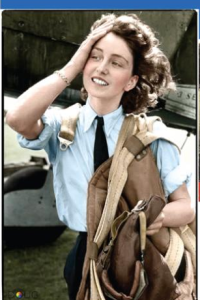
Maureen Dunlop, an Air Transport Auxiliary (ATA) pilot featured on the front cover of The Picture Post magazine on the 16th September 1944. One in ten female pilots died flying for the ATA. Maureen died at the age of 91 in May 2012. Jane says: “She became the glamorous cover girl image of the war. People loved this image as it showed women could be brave and beautiful.”
The other bit of research that moved me deeply was the plight of the Staffordshire Bull Terrier or Staffie as they are commonly known. They are the most abused breed and a huge percentage of dogs in rescue centres are Staffies. They are loyal beautiful dogs – known as the nannie dog as they actually are so good with children. Even so, they have gained an undeservedly bad reputation through the media, as so many lads like Finn and his gang in How to Fly choose this breed to strut down the street with thinking it makes them look tougher. This powerful and brilliant RSPCA You Tube video Britain Love Your Staffie, really tugged at my heart strings.
I thought back to the books I had read as a child and so often it was a Collie dog, or Retriever or a lovable but scruffy mongrel, but I couldn’t think of any story with a Staffie –and so Buster was born. He was such fun to write and I thought it an interesting dynamic to make him Finn’s dog but a total softie, showing the true nature of the breed. As they say there are no bad dogs, only bad owners.
Dogs Trust Harefield were so supportive with what I was trying to do with Buster. Richard Moore, the manager met with me and introduced me to the dogs. I had a lovely morning playing with and having my photograph taken with Shireen, a beautiful little white Staffie, for the inside of the back cover of How To Fly With Broken Wings. Shireen, I am thrilled to say, found her forever home the week after the photo session and is so happy with her new family.
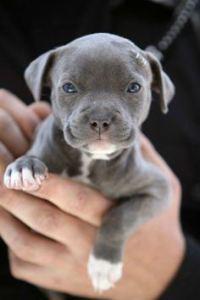
From Jane’s Pinterest board and her inspiration for the Staffie Buster in the novel (and coz it’s too cute, I couldn’t resist!) Source: petsandlove.net
4.) You are appearing at YA Shot in Uxbridge this year on a panel about tackling sadness in fiction for younger teenagers. Is it crucial for you as an author to get an important message across in your books?
I never write a book thinking I want to get a message across. The story is always paramount but through the characters issues naturally arise and it’s important I am responsible about this. I am very aware that children in the MG age range 8-12 often are dealing with the same issues as the YA age group. It is important to me reaching out to those children. I applaud Jacqueline Wilson for the subjects she has tackled and I feel that she has paved the way for other authors to be able to do this.
5.) Do you believe that libraries still play an important role in inspiring young people to read?
Yes definitely. I think there is something very precious about choosing a book in a library, taking it home, getting lost in the story, then bringing it back and exchanging it for another story to treasure. I still remember my first trip to the library when I picked Orlando, a story about a ginger cat who had adventures. In my job as an author I have seen some amazing libraries, both public and in schools. I love it when they are lively and the hub of the school or community. They are also relatively safe places for children to go when they have nothing else to do in the long school holidays. I see time and time again in my local library, flocks of children drifting in off the streets and shifting through the books then finding something that captures their imagination and sitting there quietly for hours lost in another world. That’s magical really if you think about it. Libraries are vital to the community and must be protected.
6.) Have there been any authors in particular that inspired you as a writer?
I realize the books I read as a child inspired me to be on the path I am now – but of course I did not realize it at the time, as it never occurred to me that I could be a writer. It was beyond my imagination as I spent my whole time at school being punished for my bad spelling. However the stories I wrote were passed under the desk and read by the other kids in secret during science – yet still the penny did not drop that maybe, just maybe I had a knack for storytelling.
When I was a child I loved books by Noel Stretfield particularly When The Siren Whaled – I performed a piece from that book to get into my after school drama classes. It really is a wonderful book. The other book of hers I loved was Ballet Shoes. I think this book had a major influence in my ending up in the theater. I have a flare for improvisation, so making up stories and reading and performing them was the passion of my life – yet still it didn’t occur to me that maybe I could write stories down. I also read all the Enid Blyton books, of course. If you had told me when I was a child that I would grow up and be published by Hodder Children’s Books who also publish Enid Blyton and Noel Stretfield, I would never have believed you in a million years.
When I met my editor, Naomi Greenwood, for the first time she asked me about my background. Naomi said something along the lines of – you have always been on the path to this moment, only you didn’t realize it. I remember looking round and seeing all the displays of Enid Blyton and Noel Stretfield books and it was a really profound moment, like my life suddenly made sense.
Horse books were also my passion as a child – I loved Black Beauty and My Friend Flicka. On my next book cover, Swimming To The Moon, Michelle, my lovely designer is going to put a horse on the front! This is the ultimate dream for me – I am so excited. I like to relax by going to Kentish Town City Farm to see the horses in particular Winston a big black cob who I have really bonded with.
Entering the world of children’s books as an adult, there are many writers who have inspired me. For example, the late Siobhan Dowd – Solace of the Road is a stunning piece of literature; David Almond’s Skellig is one of my favorite books of all time; I also love Hilary Mckay. Naomi, my editor gave me a copy of Permanent Rose. I loved it so much and promptly went out and bought the whole Casson Family series. Hilary’s writing is just delicious. I was so honoured that one of my first author appearances was at the Hay Festival on a panel with Hilary Mckay.
7.) How do you see the future of YA/MG fiction?
I think as the world changes the stories that need to be told naturally evolve with the issues young people face. But I always hope that young people will continue to read classic books from days gone by. I think it is important to understand the stories of the past to make sense of the present.
7.) Are you working on anything now and can you tell us a little bit about it?
The book I am writing on now is called Swimming To the Moon about a quirky, very clumsy girl called Bee who has a love of hats. Bee can’t swim, yet accepts a double dare to enter a sponsored swim to raise money for the local old people’s home where her great grand Beatrix lived before she died. Bee misses her so much she can’t breathe. Then she meets Moon-Star Higgins a traveller, who feels like a trapped animal in school. The two make a pact by the Promise Tree in the woods that cannot be broken and both their lives are changed forever.
Swimming To The Moon is a book about love and grief and reaching for your dreams.
And now for some quick fire questions!……
E book or real book?
Real books – every time, I love the smell and touch of a book and the satisfaction of holding it in your hand and finishing it.
Series or stand alone?
Both – some standalones stay in your memory forever and are perfect just as they are. There is something very exciting though about reading a series. I mentioned the Casson Family series earlier by Hilary McKay. It’s lovely to have a whole collection on your shelf.
Fiction or non-fiction?
Fiction – I love to escape into another world. However, doing research gives me a chance to explore non-fiction books I would never normally read.
The How to fly A Spitfire manual springs to mind!
Online shopping or bookshop trawling?
Bookshop trawling definitely. I love exploring bookshops – all those possibilities! I love it when I am visiting new places and suddenly come upon an independent book shop to explore.
Bookmarking or dog-earing?
Bookmarking without a doubt. I have a whole collection including a beautiful one that my friend Chris embroidered for me. However sometimes I grab anything to hand to mark my place and forget it’s there. I love it when years later I come upon notes and all sorts of treasure within the pages of my books.
My dad used to put leaves in between the pages of his nature books. They were really beautiful.
Once again, thank you so much to Jane for her efforts in making this interview possible. How To Fly With Broken Wings was published on 3rd March 2015 by Hodder Children’s Books and is available from all good book retailers. Why not check out her awesome debut novel, A Room Full of Chocolate too?
Coming tomorrow on bibliobeth – my review of How To Fly With Broken Wings.

